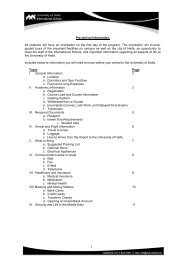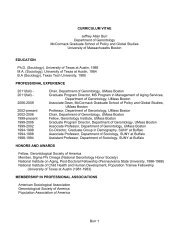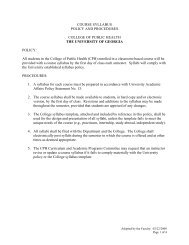MEASUREMENT MANUAL - College of Public Health - University of ...
MEASUREMENT MANUAL - College of Public Health - University of ...
MEASUREMENT MANUAL - College of Public Health - University of ...
Create successful ePaper yourself
Turn your PDF publications into a flip-book with our unique Google optimized e-Paper software.
SCALE<br />
DEVELOPMENT<br />
RELIABILITY<br />
NARRATIVE<br />
The MVPP study (Miller-Johnson, Sullivan, Simon, & MVPP, 2004)<br />
conducted a set <strong>of</strong> confirmatory factor analyses (CFA) to compare a onefactor<br />
model with a two-factor model. The reasoning behind this comparison<br />
was that aggressive and non-aggressive solutions to conflict might represent<br />
two distinct constructs (two-factor model) instead <strong>of</strong> being opposite ends <strong>of</strong> a<br />
unitary construct (one-factor model). The models were compared using tauequivalent<br />
models, where all items loadings are constrained to 1. The table<br />
below summarizes fit indices. These analyses suggest that the two-factor<br />
model provided a better fit for the data. In the MVPP study, the two<br />
subscales had a moderate, negative correlation <strong>of</strong> -.45.<br />
Model Chisquare<br />
1. One factor with all<br />
10 items<br />
2. Two correlated<br />
factors (Support<br />
Fighting and Support<br />
Peaceful Solutions)<br />
df Chi-square<br />
change<br />
(with df<br />
change)<br />
RMSE<br />
A<br />
CF<br />
I<br />
2540.01 44 0.16 .88<br />
1291.73 42 1248.28(2) 0.11 .94<br />
The internal consistency <strong>of</strong> the total scale’s scores (Cronbach's Alpha) was<br />
.81 (Orpinas, Murray, & Kelder, 1999).<br />
In the MVPP study, the internal consistency <strong>of</strong> the scores <strong>of</strong> each subscale,<br />
as measured by Cronbach’s alpha, was :<br />
• Aggressive Solutions Scale = .62<br />
• Non-aggressive Solutions Scale = .66<br />
Parental Support for Fighting was designed to measure students' perception<br />
<strong>of</strong> their parents’ support for aggressive and non-aggressive solutions to<br />
conflict. The 10-item measure was developed for the Students for Peace<br />
Project (Orpinas, Murray, & Kelder, 1999) as one scale, and later used for<br />
the MVPP project (Miller-Johnson, Sullivan, Simon, & MVPP, 2004) as two<br />
subscales with five items each: Parental Support for Aggressive Solutions<br />
and Parental Support for Non-aggressive Solutions to conflict. At the<br />
beginning <strong>of</strong> the questionnaire students were asked, “Does your parent tell<br />
you these things about fighting?” Items are listed as declarative statements,<br />
and students respond yes or no to each item. An example <strong>of</strong> a peaceful<br />
solution item is, "If someone calls you names, ignore them." An aggressive<br />
solution item is, "If someone hits you, hit them back." Scores are based on<br />
the mean item response.<br />
January 2009 17
















